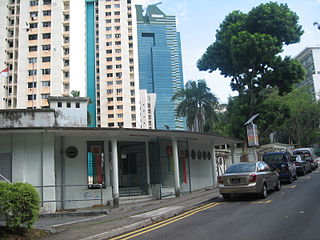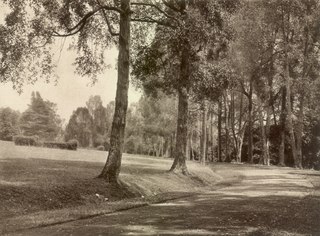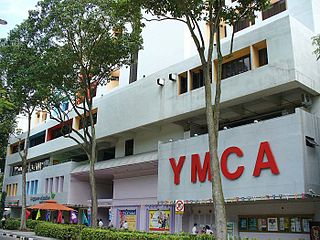
The East Coast Parkway is an expressway that runs along the southeastern coast of Singapore. It is approximately 16 kilometres (9.9 mi) in length. As of July 2022, it is Singapore's third-longest expressway.

The Economic Development Board (EDB) is a statutory board under the Ministry of Trade and Industry of the Government of Singapore that plans and executes strategies to sustain Singapore as a leading global hub for business and investment.

Clifford Pier was a former pier located beside Collyer Quay at Marina Bay within the Downtown Core of the Central Area, Singapore. The pier, which opened in 1933, ceased operations in 2006.

The Maghain Aboth Synagogue is an Hasidic Jewish congregation and synagogue, located at 24/26 Waterloo Street in Rochor, within the Central Area of Singapore. Constructed in 1878, it is the oldest and largest Jewish synagogue in Southeast Asia and the second largest in Asia itself, outside of Israel.
Lynnette Seah Mei Tsing is a Singaporean violinist, serving as co-leader of the Singapore Symphony Orchestra (SSO). She received the Cultural Medallion for Music in 2006.

Clementi Road is a road in Singapore. Part of the wider AH2 road network, it starts at Bukit Timah Road and ends at West Coast Highway. Its landmarks include Maju Camp, the Singapore University of Social Sciences, Ngee Ann Polytechnic and National University of Singapore.

Sago Lane is a one-way lane in Chinatown within the Outram Planning Area in Singapore. The street links Banda Street to Neil Road. In the past, the street was much longer and was home to funeral parlours or death houses. Part of the street was demolished in the late 1960s due to the construction of the new HDB development at Kreta Ayer, also known as Chinatown Complex. Currently the street, is mainly used during Chinese New Year as part of the festive bazaar in Chinatown.

Change Alley is an air-conditioned shopping arcade in the financial district of Raffles Place in Downtown Core planning area of Singapore. Flanked by the skyscrapers Chevron House and Hitachi Tower, it is an alley that links Raffles Place and Collyer Quay. It was renovated to what it is today in 1989, replacing the old Change Alley whose history dates back as far as 1819.

Voco Orchard Singapore is a voco hotel in located at Orchard Road, Singapore. It is the first voco-branded hotel by InterContinental Hotels Group in Southeast Asia.
Lorong Halus is an area in Pasir Ris surrounding a road of the same name. The road leads to industrial buildings and farms in Pasir Ris Farmway. It starts from the Tampines Expressway (TPE) and ends at a pier. There is a road from Lorong Halus that leads to the Lorong Halus Wetland. The wetland treats the water flowing through it, which was a former landfill.

Yan Kit Swimming Complex, located along Yan Kit Road, was the second public swimming pool in Singapore, opening in 1952 and closing in April 2001. The complex cost a total of $513,000 and pool users had to pay fifteen cents per entry. The complex closed due to a daily attendance of only 120 users by 2001.
Toa Payoh Hospital was a hospital located in Toa Payoh, Singapore. The hospital started operations as Thomson Road Hospital on 20 May 1959 and in 1997 merged with Changi Hospital to form Changi General Hospital located in Simei. The premises of the hospital was supposed to be taken over by Ren Ci Community Hospital but was eventually demolished.
David Joseph Murnane (1892–1953) was Singapore's longest serving municipal water engineer, serving from 1925 to 1947.
Robert Peirce was a British-born civil engineer who served as Municipal Engineer in Penang, Malaysia and Singapore.

Tyersall Park is an estate in Singapore, bound by Holland Road and Tyersall Avenue, and near the Singapore Botanic Gardens. Previously a private land belonging to the Sultan of Johor from 1862, some portions of it had been acquired by the Government of Singapore in 1990 and in 2009 respectively.

Istana Tyersall is a demolished historical palace that used to be in the former Tyersall Park bound by Holland Road and Tyersall Road near the Singapore Botanic Gardens in Singapore. The land it was formerly built on is currently restricted from the public.

The Fullerton Waterboat House, originally known as the Water House, is a historic water supply house formerly used to supply fresh water to incoming ships in Singapore. The former Water House was gazetted for conservation in 2002 and has since reopened as a restaurant.

Alkaff Gardens was a Japanese-style park once located east of the Bidadari Cemetery from 1930 to 1964, on the present site of Cedar Girls' Secondary School at Bidadari, Singapore. In the 1930s, the park was a popular leisure destination for dating couples and families. It featured as its centrepiece an artificial lake, which was drained in 1964.

The YMCA Building is the current headquarters of YMCA of Singapore. It also operates a hotel under the name of YMCA @ One Orchard.

Singapore Business Federation is the apex business chamber in Singapore. SBF aims to improve the organisation of the business community in Singapore and represent it both locally and abroad.


















